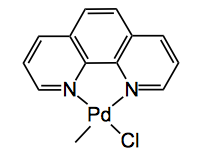Last week we had anion relays for making C-C bonds, this week sees a less energetic way, chain walking. So the Kochi lab are taking things easy in their daily routine. So what is chain walking? Well one definition is borrowed from polymer chemistry where it is a “mechanism in which an alkylmetal species undergoes a rapid β-hydride elimination and reinsertion to change the position of the metal on the alkyl chain without dissociation of the alkene during the process.” Or pictorially
where the catalyst selects which C-C bonds to construct. Mechanistically
The authors “provide a the full account of the chain-walking cycloisomerization of 1,n-dienes including (i) a vastly expanded substrate scope, (ii) an efficient isolation technique for the cycloisomerization products without the need for hydro- genation, and (iii) the results of deuterium-labeling experiments which strongly suggest the presence of the chain-walking process for this reaction.”
An actual example –
The reagents are 10 mol% of a catalyst, followed by 12 mol% NaBH4 then hydrogenation over PtO2. producing 66& GC yield of the product. The catalyst is
The 1,8-diene
produced a 91% GC yield of the cyclised product “Interestingly none of the products appeared to exceed 50% by GC analysis. It turned out, however, that the hydrogenation of the crude mixture in the presence of a catalytic amount of platinum oxide gave cyclopentane derivative in 91% GC yield with 98:2 diastereoselectivity“.
The authors go on to investigate a variety of dienes and go into detailed mechanistic studies with deuterium. Observant readers will note that such skeletal frameworks are those of the prostanes. So presumably with appropriate substitution one could end up with prostaglandins.
An interesting concept here for C-C bond formation. It would have been nice to see some more useful molecules studied but no doubt that may well come later. So get walking.
2,414 total views, 1 views today





